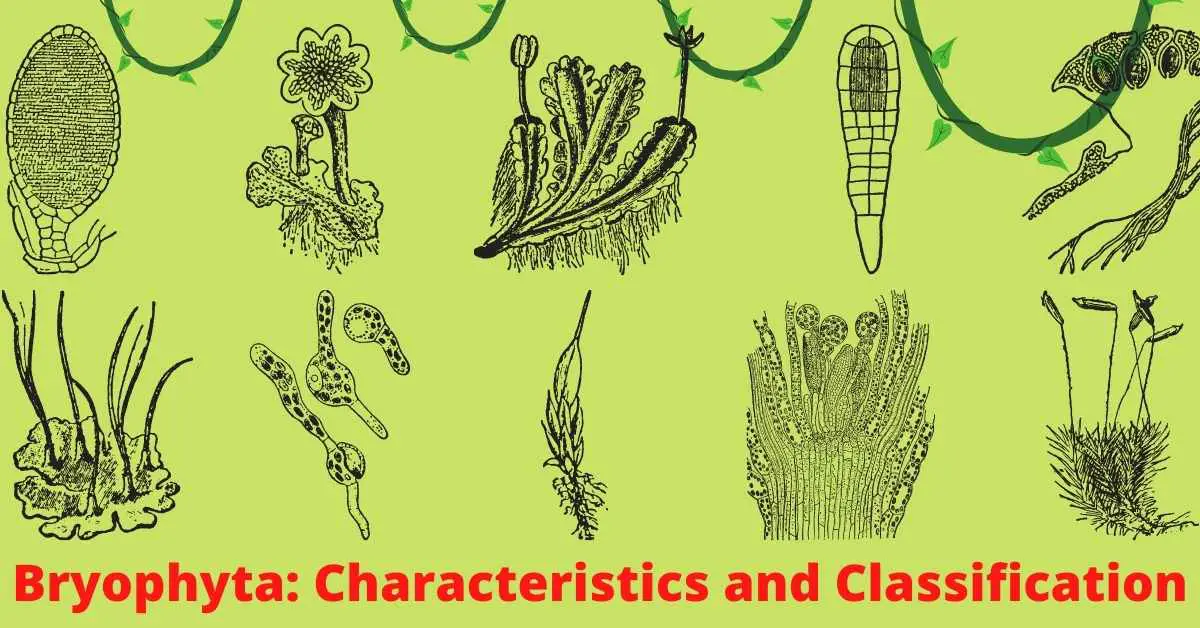The term Bryophyta is derived from two Greek words, Bryon and Phyton. In this case, ‘bryon’ meaning moss and ‘phyton’ meaning plant. It is the second division of the plant kingdom which lies in between Thallophyta and Pteridophyta. The plants included under the division are non-flowering and non-vascular. They can’t produce flowers and seeds as a result they do reproduction through the formation of spores. They are slightly advanced than the plants included under Thallophyta. The plants like hornworts, mosses and liverworts belong to the Bryophyta.
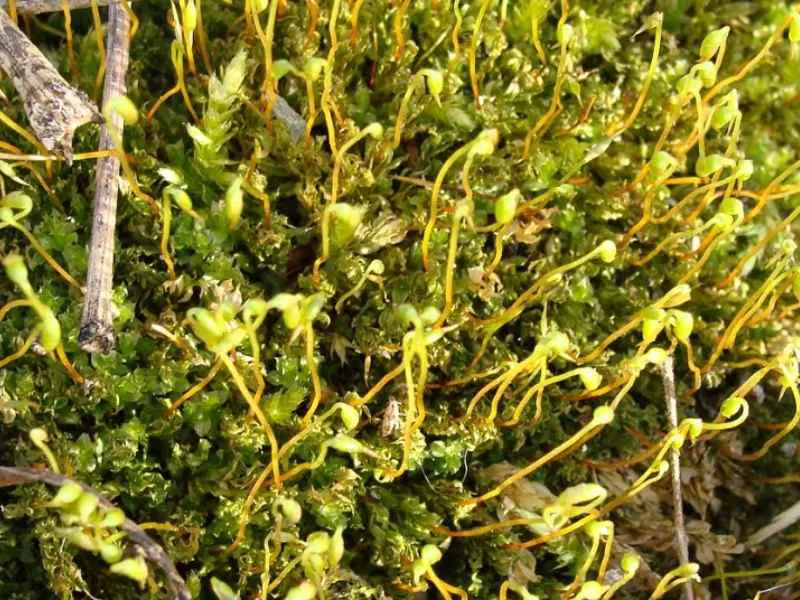
Bryophyta are typically small, simple plants that lack the specialized tissues that are found in other plants. They are all embryophytes that grow in a wide range of habitats, from damp soil to rocks and tree bark. Although some can tolerate dry conditions for short periods of time.
Bryophytes are an important part of the environment and play a role in the carbon and water cycles. They are also a key part of the food chain, providing food and shelter for a variety of animals. Bryophytes are threatened by a number of environmental factors, including pollution, climate change, and habitat destruction.
You might also read: Spirogyra: Characteristics, Structure and Reproduction
General Characteristics of Bryophyta
Bryophyta is a kind of non-flowering autophytic independent plants.
• Most of the bryophytes are terrestrial and are restricted mostly to moist and shady environments. However, certain members are epiphytic and a few are aquatic (e.g. Riccia fluitans). They are cosmopolitan in distribution.
• The gametophytic plant body of the lower bryophytes are not differentiated into root, stem and leaves, e.g. Riccia. Their body is thallus like. The thallus is green colored and generally prostrate, dorsi-ventrally differentiated. But the body of the higher groups of Bryophytes are differentiated into stem and leaves, e.g. Pogonatum. Their stem and leaves does not look like stem and leaves. Hence they are called cauloid and phylloid respectively. In case of higher bryophytes, e.g. Pogonatum, the gametophyte in immature condition looks like a filamentous structure. The type of filamentous plant body is called protonema.
• Bryophyta does not possess roots. Instead of true roots they possess unicellular or multicellular rhizoids. Rhizoids may be smooth or pegged. By the help of root like rhizoids, the plants can absorb nutrients from the soil and fixes the plant firmly to the substratum, i.e. rhizoids are developed for the purpose of absorption and anchorage. Multicellular scales are also present, e.g. Riccia. Their functions are like that of roots.
• Conducting tissue system, i.e. xylem and phloem absent in the plant body of bryophytes. Their body composed of simple, parenchyma tissue.
• The bryophytes can reproduce asexually by producing spores.
• In the history of bryophytes a definite alteration of generation is present. The autophytic plant body is the haploid gametophyte (n), which alternates with the diploid sporophytes(2n) to complete the life cycle.
• The bryophytes show heterophytic alteration of generations.
• The mature gametophytic plant body bears multicellular sex organs. The reproductive structure which help in vegetative reproduction are gemma, tuber, etc. The male sex organ is known as antheridium and the female sex organ is called archegonium.
• Male sex organs antheridia look like oval or pear shaped and are protected by a single layer of sterile cells. The antheridia possesses sperm mother cells. Each sperm mother cells produces one or two biflagellate sperms.
• The female sex organ is called archegonium. They are flask shaped and are protected by a single layer of sterile cells. The swollen base of the archegonium is called venter and the upper elongated portion is called neck. The venter is composed of a ventral canal cell and egg cell. The egg cell contains egg (n). The neck is composed of several neck canal cells.
• Water is essential for fertilization. Sperm enter within the archegonium and fuses with the eggs of the venter to form a diploid zygote (2n). The zygote develops into an embryo within the venter of the archegonium.
• The embryo gradually develops into a diploid (2n) sporophytic plant. During the development of the embryo a sheath is produced from the venter of the archegonium called calyptra.
• The sporophytic plant is always attached with the gametophytic plant and for growth and nutrition fully dependent upon the gametophytic plant.
• The structure of the sporophytic plant is very simple. The sporophytic plant may be a spherical capsule without rhizoids or scales, e.g. Riccia, or it may be differentiated into foot and capsule, e.g. Anthoceros or may be differentiated into basal foot, a stem like seta (stalk) and a terminal spores producing capsule, e.g. Progonetum.
• The capsule contains sporangium within which lies spore mother cells, e.g. Pogonatum. In case of Riccia, capsule acts as a sporangium, which contains diploid spore mother cells (2n). The spore mother cells (2n) by reduction division produces spores (n). As all the spores formed are alike hence called homospore. For that reason the bryophytic plants are homsporous.
• Each spore (n) on germination produces a kind of green filamentous structure called protonema. The bud produced on protonema by means of direct germination produces a haploid gametophytic plants.
• The Bryphytes show heteromorphic alternation of generation. In their life cycle, there are two morphologically distinct types of plants-one is gametophyte or haploid plant and the other one is sporophyte or diploid plant. The gametophyte is independent because it possesses chloroplast containing cells and rhizoids. It bears multicellular sex organs.
• The sporophyte is attached to the gametophyte and the former is largely dependent on the latter for its nutrition.
Classification Of Bryophytes
Bryophyta is divided into the following three classes:
Class-1: Hepaticopsida (Liverworts)
Class-2: Anthocerotopsida (Hornworts)
Class-3: Bryopsida (Mosses)
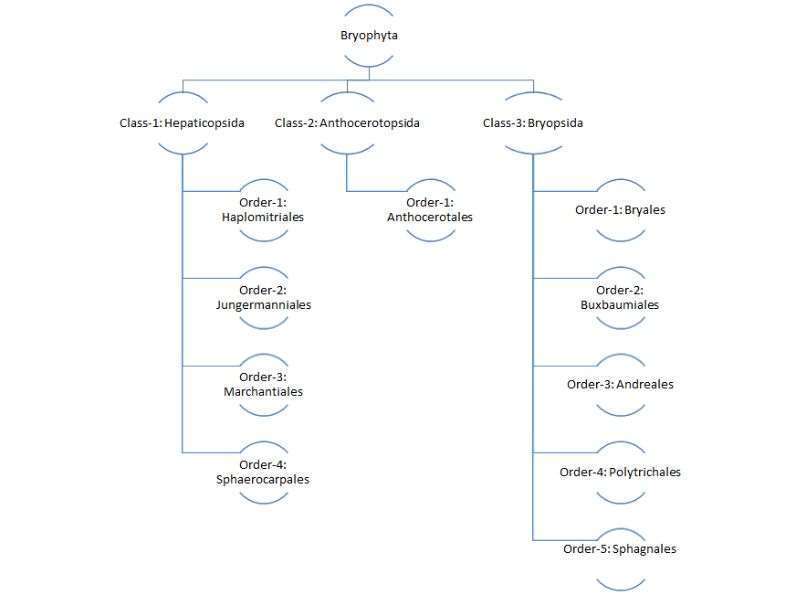
Class-1: Hepaticopsida (Liverworts)
Gametophytic plant body generally thallus like, prostrate and dorsiventrally are differentiated.
• The thallus may be simple e.g. Riccia or with leaf-like appendages, i.e. foliose, e.g. Porella.
• Many chloroplasts without pyrenoids are present in each cell of thallus.
• From the dorsal surface of the thallus, develops unicellular rhizoids and multicellular scales.
• Sex organs are placed on the dorsal side of the thallus.
• The sporophytic plant body may be very simple or differentiated into foot, seta and capsule.
• The sporophyte is always dependent upon the gametophyte for nutrition and growth, e.g. Riccia, Marchantia, etc.
• The capsule does not contain the columella.
• Sporogenous tissues are produced from the endothecium.
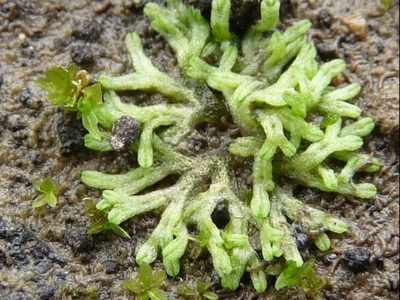
Reproduction
Asexual reproduction: Bryophytes do reproduction through the process of fragmentation or by the gemmae formation. In this case, gemmae are asexual buds produced within the gemma cups. Gemmae are multicellular and green colored. A new plant is produced from gemma cup after detaching from the mother plants.
Sexual reproduction: Antheridium and archaegonium are the male and female sex organs respectively. In this case, both the male and female sex organs may be present on the same thallus or different thallus producing sperms and eggs respectively. The sperm and egg meet together through the fertilization process and form zygote. A diploid sporophyte is produced from the zygote. Due to meiosis of the few cells of the sporocyte, haploid spores are formed. These haploid spores transfer into haploid gametophytes. In this case, these gametophytes are free-living and they produce food through the photosynthesis process.
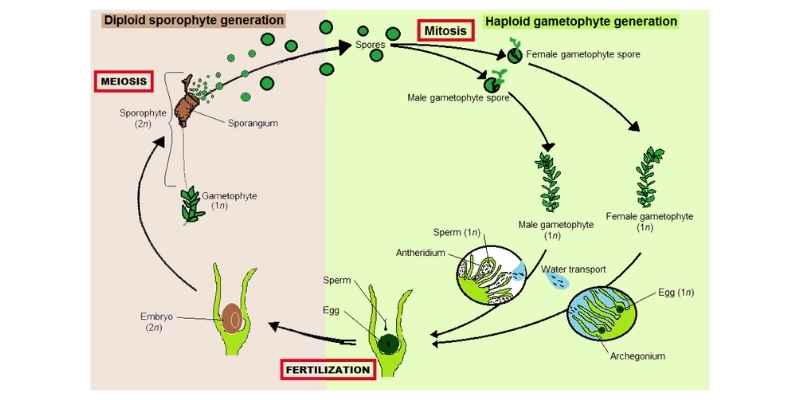
Class Hepaticopsida includes the following four orders:
Order-1: Marchantiales: The representatives of of order marchantiales are known as liverworts or complex thalloid liverworts. They are creeping ribbon-like plants and are commonly found on silty soils and moist clay. They are also found in the river sides. Examples: Riccia, Marchantia.
Order-2: Sphaerocarpales: Under the liverworts, Sphaerocarpales is a plants order which contains about twenty species. It is also known as bottle liverworts. This order is also divided into four families including Sphaerocarpaceae, Monocarpaceae, Riellaceae, and Naiaditaceae(extinct).
They have leafy gametophyte which consists of alternately two rows of inserted lobes of leaves. The sporophyte is similar to those of Marchantiales. The sex organ contains flask-shaped or globose envelope. Examples: Sphaerocarpos.
Distribution and Habitat: They prefer to live in terrestrial condition. It is found chiefly in the Gulf and Pacific coast. Mostly grow in shady, moist and colder places. If you change the habitat of it, the thallus is changed.
General Characteristics
It has thalloid gametophytic body but it contains leaves on the dorsal surface of axis.
•
• They have no ventral scales but the growing points of the plant contains mucilaginous hairs.
• It does not contain tuberculate rhizoids but smooth-walled rhizoids are present.
• They do not contain air pores, filaments and photosynthetic chambers.
• Antheridium or archegonium is covered with involucre or bottle.
• They do not contain elaters
• The sporophyte is look-like small foot with very small seta and a globose capsule.
• The capsules have no thickening bands and it is one-layer thick.
• The capsule also contains nurse cells with developing spores for providing nourishment.
Reproduction: Sphaerocarpos can reproduce vegetatively using Dichotomous branches and Adventitious branches. In case of sexual reproduction, both male and female plants are separate and externally, they differ from each other. The male plant is comparatively smaller in size than the female plants.
Order-3: Haplomitriales (formerly Calobryales):This order contains single genus Calobryum and 12 species. They have flattened leaves which occur in three rows on an erect shoot. They lack rhizoids. Sporophytes have elongate seta. Sporangium is elongated with elaters. Examples: Calobryum
Order-4: Jungermanniales: It is the largest order of class Hepaticopsida which contains 244 genera and more than 9000 species in the division Bryophyta. They are also known as leafy liverworts. They have leaf-like flaps which are placed on either side of the stem. Leaves are flattened which occur in 2-3 rows. Rhizoids have smooth wall. Sporophyte contains seta and sporangium is spherical to elongate with elaters. Examples: Pellia
Class-2: Anthocerotopsida (Hornworts)
This class contains about 300 species under one order, Anthocerotales. It is commonly called hornworts.
• Gametophytic plant bodies are dorsiventrally differentiated, prostrate and thallus like.
• From the dorsal surface of the thallus generally develops smooth walled rhizoids.
• Scales does not develop.
• Internal tissue differentiation is absent.
• Sex organs are embedded within the tissue of the gametophyte.
• The sporophytic plant body is differentiated into foot and capsule.
• On the lower portion of the capsule always lies meristematic tissue.
• The sporophytic plant body is partly dependent upon the gametophytic plants body, Anthoceros, etc.
Examples: Anthoceros, Megaceros, Notothylas.
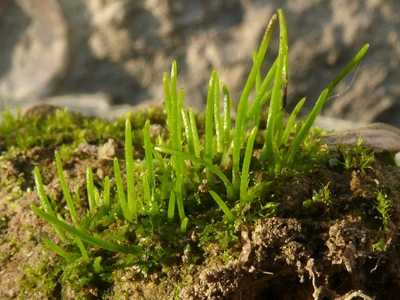
Reproduction: Both asexual and sexual reproduction occur in Anthocerotopsida. Asexual reproduction is occurred through the fragmentation of thallus and tubers under unfavourable conditions.
Sexual reproduction occurs through the production of waterborne sperms. In this case, sperm start traveling from antheridium to archaegonium. As a result, in the sporophyte, fertilized eggs develops. Sporophyte produces spores by splitting lengthwise and form gametophyte phase.
Class-3: Bryopsida (Mosses)
Bryopsida (mosses) is the largest class under Bryophyta which contains about 1400 species. The representatives of bryopsida are commonly known as mosses. The main Characteristics of Bryopsida are:
• Two stages are noted in the gametophytic plants, like (1) prostrate, branched, short lived, thallus like protonema and (2) long, erect gametophore stage, differentiated into stem like axis, leaf like phylloid and multicellular, branched, rhizoids instead of roots.
• Sex organs are located superficially in groups at the tip of the stem which looks like an inflorescence.
• The sporophytic plant body may be differentiated either into foot and capsule or differentiated into foot, seta and capsule.
• The sporophytes are partly dependent upon the gametophytes.
• Spores are formed from the sporogenous tissue.
• Elaters are absent but columella is present.

The class Bryopsida is again divided into the following five orders:
- Bryales
- Buxbaumiales
- Andreales
- Polytrichales
- Sphagnales
Reproduction: Both asexual and sexual reproduction occur in Bryopsida. Secondary protonema takes part in asexual reproduction by budding and fragmentation and produces new plants.
The apical part of leafy shoots contain antheria and archaegonia. In the sexual reproduction, antheria and archaegonia unite together and fertilization occurs and sporophyte is produced and gametophyte occurs from the spores.
Characters of Bryophyta Resembling Pteridophyta
• Life history shows distinct and well defined heteromorphic alternation of generation.
• Presence of multicellular sex organs (Male sex organ-Antheridium and female sex organ-Archaegonium).
• Oogamous type of sexual reproduction.
• Formation of multicellular embryo. Embryo development takes place within the venter of the female sex organ, archegonium.
• Fertilization occurs in presence of water.
• Sporophytic generation ends with the development of spore mother cells and the gametophytic generation initiates with the germination of the spores.
Economic Importance of Bryophytes
Bryophyta, a division of nonvascular plants, play an important role in the economic stability of ecosystems. These plants are integral in the development and maintenance of wetlands and peatlands, which provide numerous ecological services. Bryophytes also have potential for use in bioremediation and phytoremediation projects.
The ecological importance of bryophytes is well documented. Wetlands and peatlands are among the most productive ecosystems on Earth, providing many valuable services to humans and other species. Wetlands filter water as it moves through them, removing pollutants before they reach larger bodies of water; they also act as buffers against flooding events (Wetland Science). Peatlands sequester carbon dioxide from the atmosphere, helping to mitigate climate change; they also support a diverse array of plant and animal life (Peatland Action). Bryophytes play an important role in both wetland and peatland development and maintenance by binding soils together with their roots, regulating water flow, preventing erosion, etc.
In addition to their roles in wetlands/peatlands ecosystems, bryophytes have potential for use in bioremediation or phytoremediation projects – that is, using plants to clean up polluted areas. For example, mosses can be used to remove heavy metals from soil or groundwater, making them potentially useful tools for remediating contaminated sites.
Conclusion
In conclusion, Bryophyta is a fascinating world of mosses that is full of diversity and wonder. They are found in a variety of habitats, including forests, deserts, and tundra. Bryophytes are an important part of the global ecosystem and play a vital role in the carbon and water cycles. They are a great addition to any garden. If you are looking to add some moss to your garden, Bryophyta is a great place to start.

